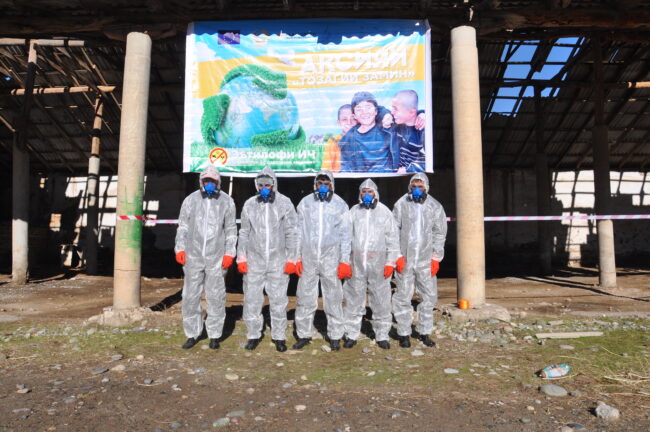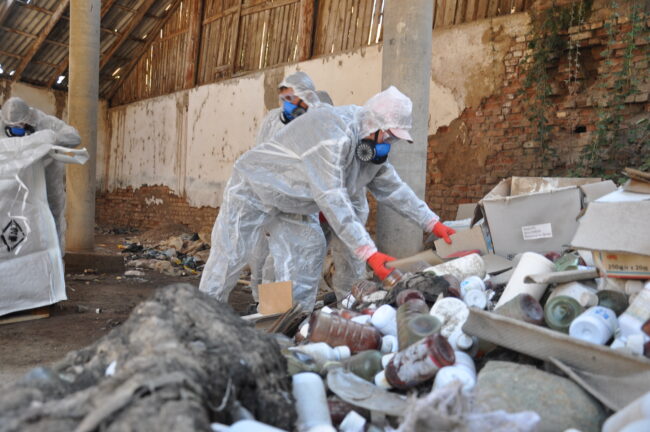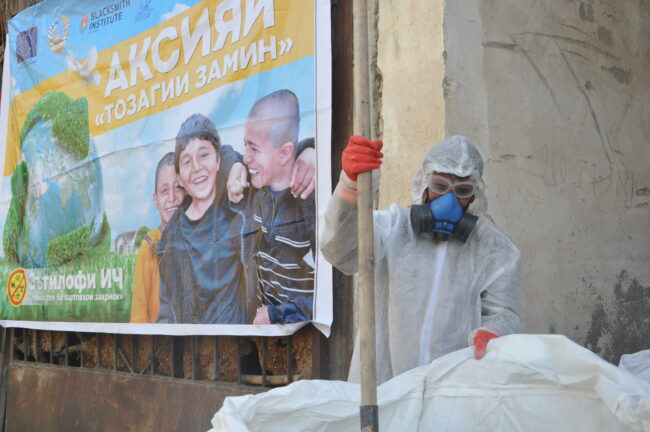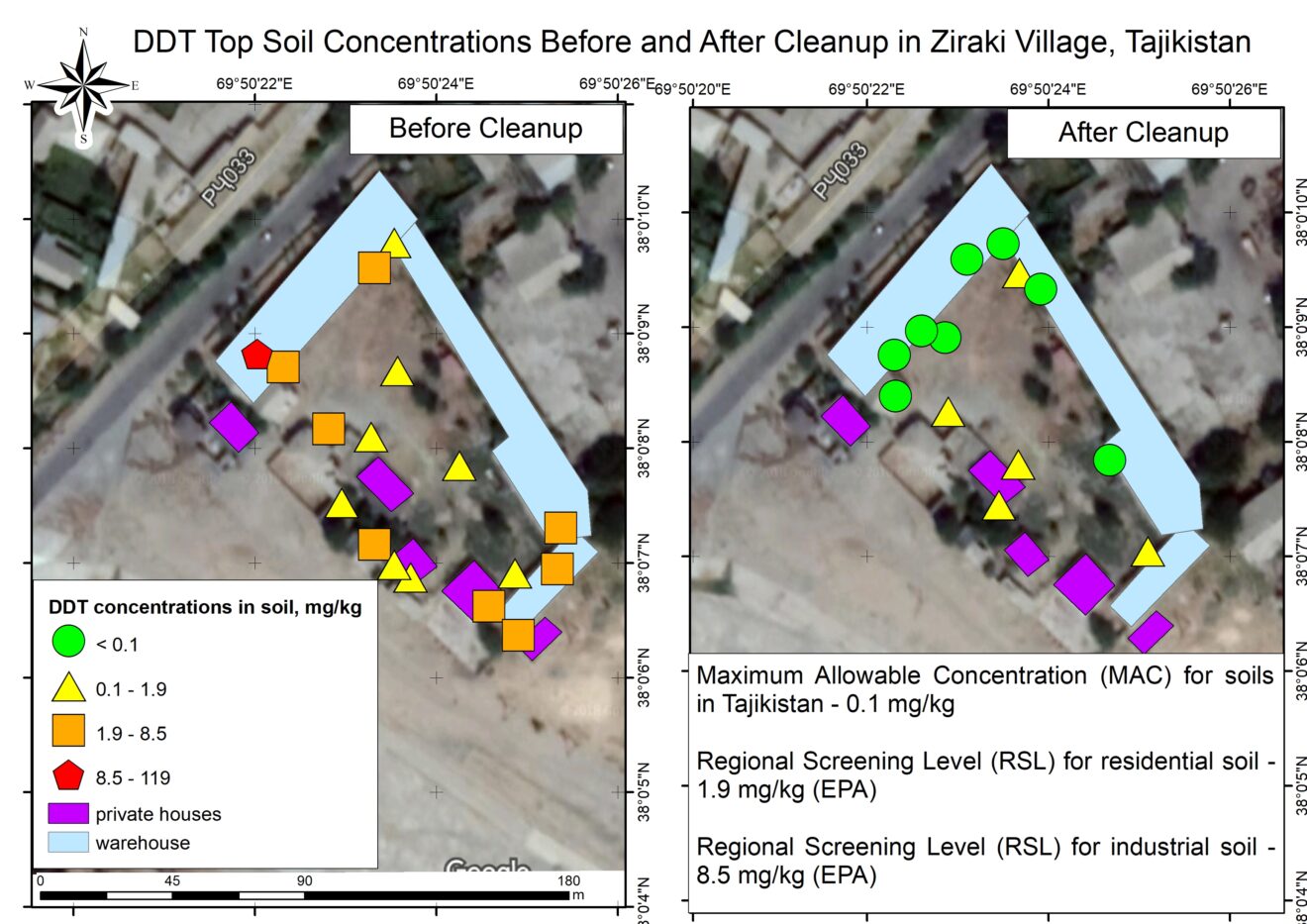Cleanup of Obsolete Pesticides Burial in Ziraki, Kulyab District, Tajikistan
Project dates: 2019-2020
Number of people at risk: 1,000 residents
Source of pollution: Burial of obsolete pesticides, DDT
Project implementers: NGO “Peshsaf”, Environmental Protection Committee
Total cost: $16,000 the project was funded by European Commission, the assessment was co-funded by USAID and some travel costs were covered by Trust for Mutual Understanding.
The project was implemented in 2019-2020 by current EHPMI member CSO Peshsaf with the financial and organizational support of the EU/ Blacksmith Initiative UK and the Environmental Protection Committee under the Government of the Republic of TajikistanProject dates: 2019-2020Number of people at risk: 1,000 residentsSource of pollution: Burial of obsolete pesticides, DDTProject implementers: NGO “Peshsaf”, Environmental Protection CommitteeTotal cost: $16,000 the…
DDT – General Information
The term DDT refers to p,p’-dichlorodiphenyltrichloroethane. DDT, prepared by the reaction of chloral with chlorobenzene in the presence of sulfuric acid, was first made in 1874; and its insecticidal properties were discovered in 1939 by a Swiss chemist, Paul Hermann Müller. DDT (dichloro-diphenyl-trichloroethane) is considered one of the first of the modern synthetic insecticides.
DDT is applied as a dust or by spraying its aqueous suspension. The term DDT is also applied to commercial products consisting predominantly of p,p‘-DDT, but also containing smaller amounts of other compounds. All DDT isomers are tasteless, almost odorless solids.
Major uses of DDT
DDT is a non-systemic contact insecticide with a broad spectrum of activity. Growers used DDT on a variety of food crops in the United States and worldwide. Some of the crops were beans, cotton, soybeans, sweet potatoes, peanuts, cabbage, tomatoes, cauliflower, brussel sprouts, corn, and other crops. DDT was also used in buildings for pest control.
It was banned in several countries in the early 1970s because of ecological considerations, and many other countries have more recently restricted or banned its use except when it is needed for the protection of human health. Despite a ban on sales, organochlorines may still be found in storage in many countries such as Tajikistan; thus, exposure is still possible. DDT is still used in some countries for the control of vectors that transmit yellow fever, sleeping sickness, typhus, malaria and other insect-transmitted diseases.
DDT Persistence
DDT was designated as a persistent organic pollutant (POP) in 1997 by the Governing Council of the United Nations Environment Programme. Pesticide applicators are exposed primarily to p,p‘-DDT, whereas it is the p,p‘-DDE metabolite to which the general population is exposed in the diet or drinking-water.
DDT and its metabolites are persistent in the environment and resistant to complete degradation by microorganisms, although photochemical degradation does occur. The persistence of DDT is substantially lower in tropical climates than in temperate ones (a few months compared with years). DDT and its metabolites are readily adsorbed onto sediments and soils, which can act both as sinks and as long-term sources of exposure. Because of its strong tendency to be adsorbed onto surfaces, most DDT that enters water is and remains firmly attached to soil particles. If it does find its way into water, it is gradually lost by adsorption onto surfaces.
In soils, DDT is immobile under aerobic conditions with a mean half-life ranging from 2 to 15 years. DDT is metabolized by microbial systems in soils and is broken down into DDE and DDD. Significant degradation has been demonstrated in soils under anaerobic conditions, while little or no degradation was observed under aerobic conditions. Biodegradation, however, is highly variable and influenced by the populations of required microorganisms. Various amendments to soils such as energy and carbon sources, were shown to increase degradation under anaerobic but not aerobic conditions. DDT has been shown to readily degrade in certain flooded soils. DDT is apparently co-metabolized by microorganisms and is not used as a sole carbon source. Products of biodegradation include DDD and DDE and occasionally DBP (4,4′-dichlorobenzophenone).
The physical and chemical properties of DDT and its metabolites enable these compounds to be taken up readily by organisms from the surrounding medium and from food. In aquatic organisms, uptake from water is generally more important, whereas food is the major source for terrestrial fauna. High lipid solubility and low water solubility lead to the retention of DDT and its stable metabolites in fatty tissue. In general, organisms at higher trophic levels tend to contain more DDT-type compounds than those at lower ones. These compounds can be transported around the world in the bodies of animals, as well as in ocean and air currents.
In the United States, populations of bald eagles and other raptors crashed when DDT thinned their eggs, killing their embryos. The pesticide, known for accumulating in food webs and persisting in soil and river sediment, was banned in the United States in 1972. Studies in animals have also shown that oral exposure to DDT can cause liver cancer.
DDT is classified as “moderately toxic” by the US National Toxicology Program (NTP) and “moderately hazardous” by WHO, based on the rat oral LD 50 of 113 mg/kg. Indirect exposure is considered relatively non-toxic for humans. The International Agency for Research on Cancer (IARC) classified DDT as Group 2A “possibly carcinogenic to humans”. EPA has determined that DDT, DDE, and DDD are probable human carcinogens as of January, 2015.
Current concerns surrounding DDT are that it is an endocrine disruptor. Endocrine disruptors are chemicals that can interfere with endocrine (or hormone) systems at certain doses. These disruptions can cause cancerous tumors, birth defects, and other developmental disorders. Any system in the body controlled by hormones can be derailed by hormone disruptors. A wide and varied range of substances are thought to cause endocrine disruption. Chemicals that are known endocrine disruptors include diethylstilbestrol (the synthetic estrogen DES), dioxin and dioxin-like compounds, polychlorinated biphenyls (PCBs), DDT, and some other pesticides.
Pesticides in Tajikistan
Before the collapse of the Soviet Union, pesticides and other chemicals were actively used in Tajikistan’s agriculture. The application of different pesticides was often done without proper adherence to the existing rules and standards and without consideration of the climatic conditions in different areas.
The range of pesticides used in Tajikistan included the following POPs: aldrin, dieldrin, heptachlorine, endrin, hexachlorinebenzene, toxaphene, chlordane, DDT, endosulphane, and lindane. On average, about 14 thousand tons of pesticides were brought to Tajikistan every year. The share of DDT constituted from 33 to 80% of the total volume of pesticides. About 90 thousand tons of DDT were brought to Tajikistan during the period of active use of this insecticide.
In 1970, by the decree of the Minister of Health of the Soviet Union, application of DDT was banned in agriculture and, in 1987. DDT was banned for use to control vector-borne diseases. In the 1980s and through the beginning of 1990s, the use of other pesticides-POPs was also banned. Despite the ban, the remaining pesticides were still used, though in much smaller volumes.
Currently, the threat of obsolete pesticides to the health of people and the environment in Tajikistan still exists. During the Soviet time, the amount of pesticides brought to Tajikistan exceeded actual application needs by 1.5-2 times. As a result, excessive volumes of pesticides were accumulating in multiple storages and distribution centers of “Tajikselkhozkhimiya” Republican Service. Because there were so large volumes of unused pesticides, various violations occurred: pesticides were distributed to individuals for uncontrolled use in their gardens, some pesticides were dumped in municipal landfills or secretly buried. In the 2000s and because of small supplies of pesticides to Tajikistan, the existing volumes of obsolete pesticides were used again in agriculture. People particularly preferred using DDT and excavated the waste chemical from the Vakhsh polygon, where more than 9 thousand tons of DDT were buried. The customs of Tajikistan registered some cases of illegal import of DDT, including the case of bringing 7 tonnes of DDT from Uzbekistan.
Today, agriculture is an important part of Tajikistan economy, generating about 24.2% of GDP (2015). The total area of land used for growing various crops exceeds 900 thousand hectares. Much attention was also paid to the agricultural sector while Tajikistan was part of the USSR. In Tajikistan there were significant areas of agricultural land for growing crops, especially cotton, and millions of rubles were spent on building infrastructure, as well as providing the industry with agrochemicals and pesticides. The development of agriculture, and, above all, cotton growing, in Tajikistan was closely linked to the widespread use of pesticides to control agricultural pests, plant diseases, and weeds.
Site Description
The former pesticide storage is located in Ziraki Village, Kulyab District of Khatlon Region.
It was found that three families of 10 people (four of them children) lived in the former pesticide storage zone. According to the families, children played inside the former warehouse building and animals grazed in the area. The main pathways of exposure were inhalation of vapors, ingestion of soil/dust, and consumption of contaminated crops and animal products.
Site Assessment
The site was initially assessed in 2016. The project team found empty bottles with Chinese labels, plenty of damaged bags with DDT, cotton seeds covered in red substance which was suspected to be mercury-containing pesticide granozan, and drums with some unknown substance. There was strong chemical odor at the site.
The owners of the warehouse privatized the premises and almost the entire territory for personal use. There were some obsolete pesticides remaining in the warehouses and the soil in the area was contaminated. The owners were warned about the toxic effects of the chemicals.
The investigation team took samples and analyzed them in the Institute of Chemistry of the Academy of Sciences of the Republic of Tajikistan. The maximum concentration of DDT in soil exceeded the baseline values of Tajikistan (0.1 mg/kg) by 61 times. The regional soil level (RSL) for residential soil (1.9 mg/kg) was exceeded by 3.2 times.

In October 2018 the project team conducted the Detailed Site Assessment (DSA). More extensive soil sampling was conducted to estimate the volumes of contaminated materials and propose risk reduction alternatives.
The total area contaminated with DDT in Ziraki was estimated about 1 hectare meters and the estimated volume of contaminated materials was 2 metric tons.
Preparing for Remediation
The project team met with the Head of District Administration (Hakim) and local administration to discuss the findings of the conducted assessments and the feasibility of risk reduction activities. The local administrators expressed support for the assessment activities and promised to help with the coordination and implementation of future risk reduction measures. The project team also interviewed local residents to find out about the contamination distribution patterns and known health impacts.
Project team developed the alternatives analysis matrix to choose the best course of actions to reduce health risks at the site.
The following alternatives were considered:
A. No action;
B. Repackaging of obsolete pesticides and removal to Hazardous Waste Storage;
C. Repackaging and safeguarding obsolete pesticides on site;
D. In situ treatment of obsolete pesticides through biodegradation;
E. Biodegradation of pesticides in bioreactors (mobile plants)
F. In situ treatment of obsolete pesticides through destruction with special equipment (Burning pesticides in special modular plants);
G. The burning of pesticides in cement kilns.
The possibility of implementing of each alternative was assessed on a 5-point scale according to the following parameters: Risk reduction effectiveness; Sustainability; Logistical feasibility; Potential risks of work; Compliance with regulations and/or accepted practices; Stakeholder acceptance; Anticipated costs.
Cleanup Process
The cleanup started in October 2018. At the first day the Safety Manager Umijon Ulugov and Community Trainer Lyudmila Bobritskaya held a practical training for workers on handling the hazardous materials.


The project team marked the site with a signal tape and prepared all the necessary equipment. The area of 100 square meters was completely restricted for residents during the operation. Trucks were used for transporting the contaminated materials to the Vakhsh Polygon. Since the local residents live very close to the contaminated site and due to the difficulty to operate the excavator inside the warehouse, the workers cleaned the area manually with shovels.


After the delivery of the contaminated soil and pesticides packed in Big Bags to the facility, the trucks were washed off there in a specially designated area in order to remove contamination.
In total, about 13 metric tons of pesticides were removed and repackaged at the site. The list of found obsolete pesticides included: Thiodan – 2,271 kgs, Thiram – 150 kgs, Fenturan – 750 kgs, Fluometuron – 1,550 kgs, DDT mixed with soil – 2,250 kgs, unknown substances – 6,000 kgs, empty bottles from 0.1 to 1 liter – 10,000 pieces.
A local resident Bakhtierov Sabzalidin said: “I am thrilled to see the removal of pesticides from our community. For far too long, we were exposed to these poisonous chemicals. With the removal of these pesticides, I feel that we took a step towards healthy and sustainable future.”
Education and Awareness
In October 2018, Peshsaf with conducted the information campaign for local residents living near the contaminated area.
The project team engaged in education and awareness activities to inform local residents about the purpose of the action, about the risks of living next to former warehouses of obsolete pesticide, and about health effects of pesticides. The project team explained to the local residents how to minimize exposure to pesticides and answered questions.


Local resident Kamolzoda Jamshed: “After attending the training session about the health effects of pesticides, I have a new perspective on the use of these chemicals in our community. Before the training, I knew very little about the negative impacts of pesticides on human health and the environment. Now, after hearing from experts and learning about the potential long-term effects of these chemicals, I believe that we need to be much more cautious in handling and using pesticides.”
Post Remediation Assessment
In order to control the quality of the cleanup, the project team took soil samples and analysed them for organochlorine pesticides. The results indicated that in all samples the DDT concentrations did not exceed the Regional Screening Level for Residential Soil of 1.9 mg/kg. It means that DDT health risks for people in the area were reduced to internationally acceptable levels.
The Maximum Allowable Concentration adopted in Tajikistan is 0.1 mg/kg for DDT and in some samples the concentrations were above this value, though below 1.9 mg/kg. Since cleaning up the area to achieve compliance with MSA is impractical, the project team concludes that no further clean up action or long-term pollution controls system are necessary in the area.
Post remediation soil sampling confirmed that the cleanup project was successful in reducing DDT soil concentrations and minimizing health risks for local residents.
The map of the DDT concentrations in soil before and after cleanup is shown below.

Link to project description at PE website: Two pesticide cleanups and a wedding in Tajikistan, near the Afghan border
